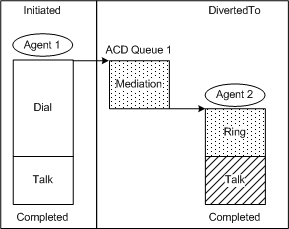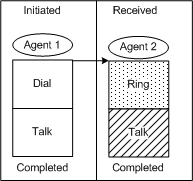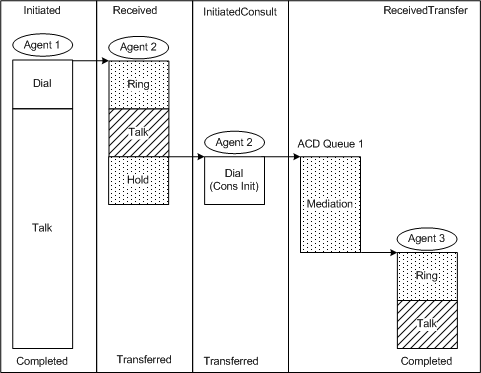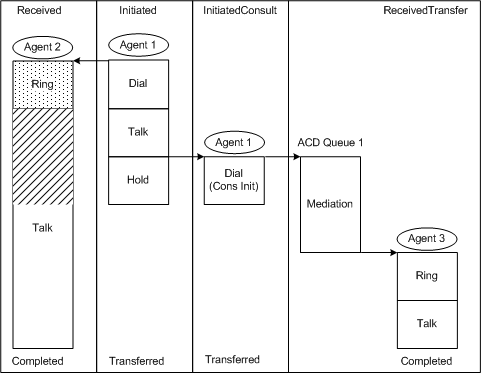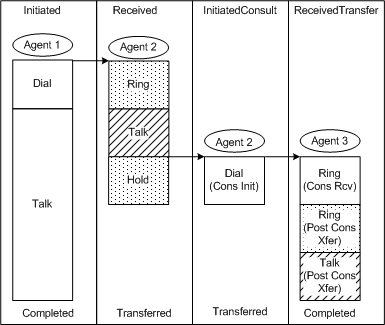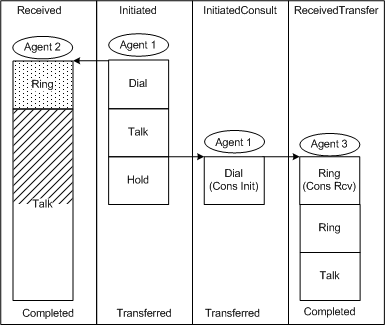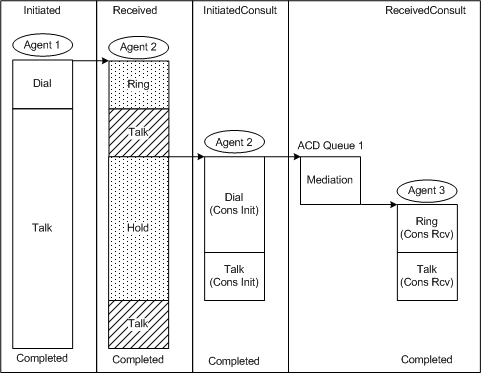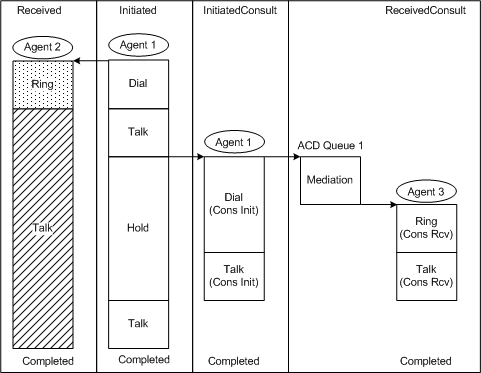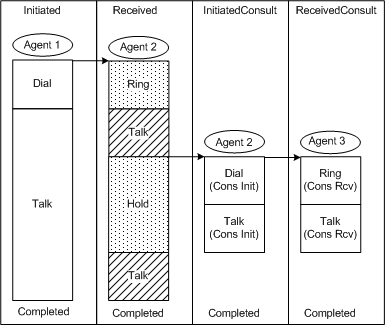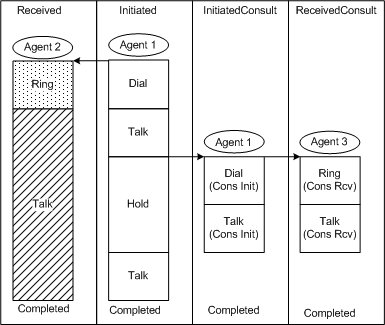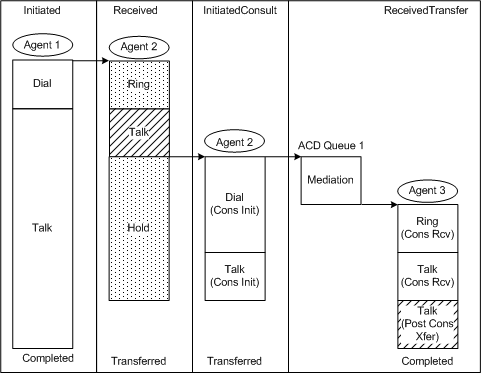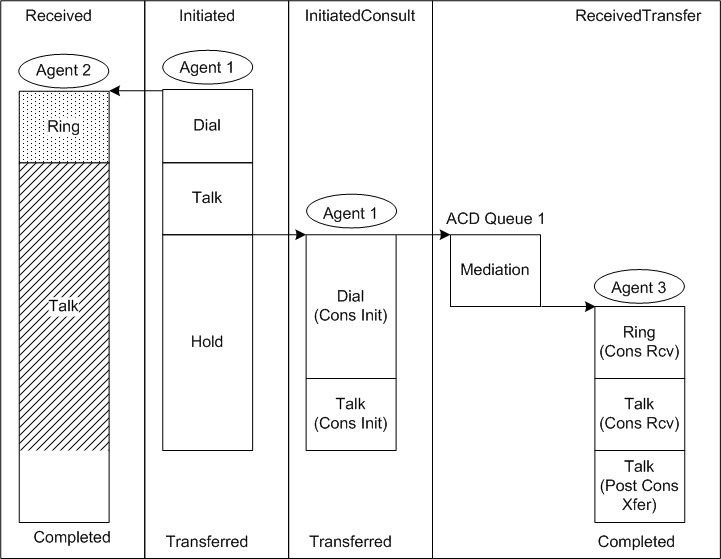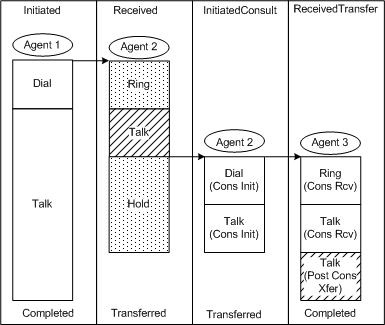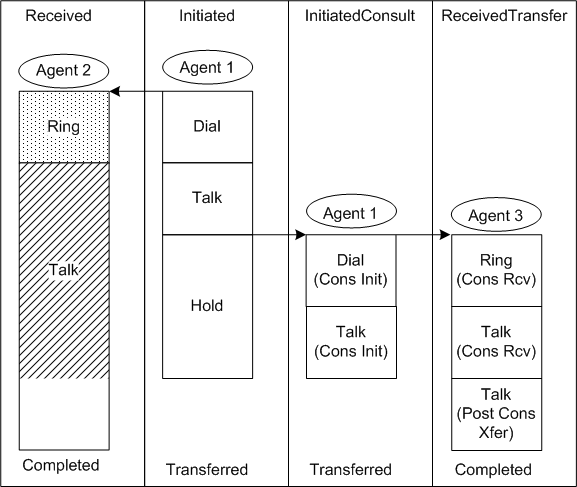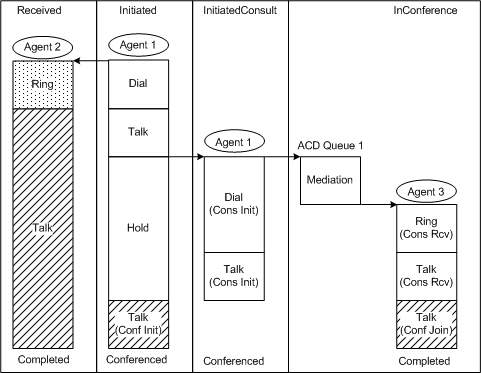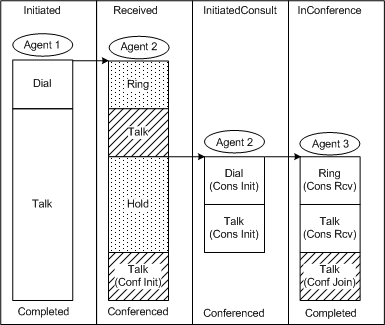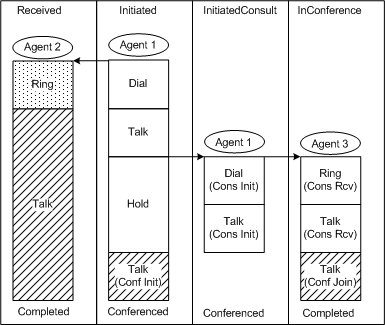Contents
- 1 Framework-Only Call Flows: Internal
- 1.1 Internal to agent via ACD queue
- 1.2 Internal to agent directly
- 1.3 Mute transfer to ACD queue
- 1.4 Mute transfer to agent
- 1.5 Consult to agent via ACD queue, and then retrieve
- 1.6 Consult to agent, and then retrieve
- 1.7 Consult to agent via ACD queue, and then transfer
- 1.8 Consult to agent, and then transfer
- 1.9 Consult to agent via ACD queue, and then conference
- 1.10 Consult to agent, and then conference
Framework-Only Call Flows: Internal
This page illustrates internal voice call flows that Genesys Info Mart supports in deployments with a basic, Framework-only solution. The following call flows are supported:
- Internal to agent via ACD queue
- Internal to agent directly
- Mute transfer to ACD queue
- Mute transfer to agent
- Consult to agent via ACD queue, and then retrieve
- Consult to agent, and then retrieve
- Consult to agent via ACD queue, and then transfer
- Consult to agent, and then transfer
- Consult to agent via ACD queue, and then conference
- Consult to agent, and then conference
For other supported call flows, see Validated Voice Call Flows.
Internal to agent via ACD queue
| This call topology shows the outcome of an internal call to an agent via an ACD queue. An agent initiates a call to the ACD queue, and the interaction is diverted to another agent.
Technical Descriptors illustrated:
|
Internal to agent directly
| This call topology shows the outcome of a call that an agent initiates directly to another agent.
Technical Descriptors illustrated:
|
Mute transfer to ACD queue
In this call topology, an agent initiates a call to another agent. One of the agents then mute transfers the call to an ACD queue, and the interaction is diverted to another agent.
There are two possible outcomes of a call that is mute transferred to an ACD queue:
Mute transfer to ACD queue — Call receiver initiates transfer
| For this outcome, the receiving agent initiates a mute transfer to the ACD queue.
Technical Descriptors illustrated:
|
Mute transfer to ACD queue — Call initiator initiates transfer
| For this outcome, the initiating agent initiates a mute transfer to the ACD queue.
Technical Descriptors illustrated:
|
Mute transfer to agent
In this call topology, an agent initiates a call to another agent. One of the agents then mute transfers the call to another agent.
There are two possible outcomes of a call that is mute transferred directly to an agent:
Mute transfer to agent — Call receiver initiates transfer
| For this outcome, the receiving agent initiates a mute transfer to another agent.
Technical Descriptors illustrated:
|
Mute transfer to agent — Call initiator initiates transfer
| For this outcome, the initiating agent initiates a mute transfer to another agent.
Technical Descriptors illustrated:
|
Consult to agent via ACD queue, and then retrieve
In this call topology, an agent initiates a call to another agent. One of the agents then initiates a consultation to an ACD queue, and the interaction is diverted to another agent. The consultation ends when the consulting agent retrieves the interaction.
There are two possible outcomes of a call that is retrieved after a consultation has been initiated:
- The call receiver (Agent 2) initiates the consultation.
- The call initiator (Agent 1) initiates the consultation.
Receiving agent consults to ACD queue, and then retrieves
| For this outcome, the receiving agent initiates a consultation to the ACD queue.
Technical Descriptors illustrated:
|
Initiating agent consults to ACD queue, and then retrieves
| For this outcome, the initiating agent initiates a consultation to the ACD queue.
Technical Descriptors illustrated:
|
Consult to agent, and then retrieve
In this call topology, an agent initiates a call to another agent. One of the agents then initiates a consultation to a third agent. The consultation ends when the consulting agent retrieves the interaction.
There are two possible outcomes of a call that is retrieved after a consultation has been initiated:
- The call receiver (Agent 2) initiates the consultation.
- The call initiator (Agent 1) initiates the consultation.
Receiving agent consults to another agent, and then retrieves
| For this outcome, the receiving agent initiates a consultation to another agent.
Technical Descriptors illustrated:
|
Initiating agent consults to another agent, and then retrieves
| For this outcome, the initiating agent initiates a consultation to another agent.
Technical Descriptors illustrated:
|
Consult to agent via ACD queue, and then transfer
In this call topology, an agent initiates a call to another agent. One of the agents then initiates a consultation to an ACD queue, and the interaction is diverted to another agent. The consultation ends when the consulting agent transfers the interaction.
There are two possible outcomes of a call that is transferred after a consultation:
- The call receiver (Agent 2) initiates the consultation.
- The call initiator (Agent 1) initiates the consultation.
Receiving agent consults to ACD queue, and then transfers
| For this outcome, the receiving agent initiates a consultation to the ACD queue.
Technical Descriptors illustrated:
|
Initiating agent consults to ACD queue, and then transfers
| For this outcome, the initiating agent initiates a consultation to the ACD queue.
Technical Descriptors illustrated:
|
Consult to agent, and then transfer
In this call topology, an agent initiates a call to another agent. One of the agents then initiates a consultation to a third agent. The consultation ends when the consulting agent transfers the interaction.
There are two possible outcomes of a call that is transferred after a consultation has been initiated:
- The call receiver (Agent 2) initiates the consultation.
- The call initiator (Agent 1) initiates the consultation.
Receiving agent consults to another agent, and then transfers
| For this outcome, the receiving agent initiates a consultation to another agent.
Technical Descriptors illustrated:
|
Initiating agent consults to another agent, and then transfers
| For this outcome, the initiating agent initiates a consultation to another agent.
Technical Descriptors illustrated:
|
Consult to agent via ACD queue, and then conference
In this call topology, an agent initiates a call to another agent. One agent then initiates a consultation to an ACD queue, and the interaction is diverted to a third agent. The consultation ends when the consulting agent conferences the interaction.
There are two possible outcomes of a call that is conferenced after a consultation:
- The call receiver (Agent 2) initiates the consultation.
- The call initiator (Agent 1) initiates the consultation.
Receiving agent consults to ACD queue, and then conferences
| For this outcome, the receiving agent initiates a consultation to the ACD queue.
Technical Descriptors illustrated:
|
Initiating agent consults to ACD queue, and then conferences
| For this outcome, the initiating agent initiates a consultation to the ACD queue.
Technical Descriptors illustrated:
|
Consult to agent, and then conference
In this call topology, an agent initiates a call to another agent. One agent then initiates a consultation to a third agent. The consultation ends when the consulting agent conferences the interaction.
There are two possible outcomes of a call that is conferenced after a consultation:
- The call receiver (Agent 2) initiates the consultation.
- The call initiator (Agent 1) initiates the consultation.
Receiving agent consults to another agent, and then conferences
| For this outcome, the receiving agent initiates a consultation to another agent.
Technical Descriptors illustrated:
|
Initiating agent consults to another agent, and then conferences
| For this outcome, the initiating agent initiates a consultation to another agent.
Technical Descriptors illustrated:
|

